by Bruce Steele | Aug 20, 2015 | Uncategorized
Paul Wellman (file)
PAIRING PINOT WITH BBQ: As both a chef and winemaker, the Hitching Post II’s Frank Ostini enters this Saturday’s grilling-meets-wine demo during the Sta. Rita Hills 10th Annual Wine & Fire Weekend with a distinct advantage — even if he isn’t cooking mammoth meat like cohort Peter Cargasacchi.
[divider style=”shadow”]
Like much of the greater wine world, Santa Barbara County is hitting a saturation point with events in which the wine itself can no longer be the only star of the show. Folks in the Sta. Rita Hills realized this back in 2006 when they started the annual Wine and Fire celebration, which pairs their world-class pinot noir and chardonnay with food cooked over open flames.
This year’s 10th annual affair — which kicks off with a party at the Sanford & Benedict barn on Friday night, peaks at the La Purisima Mission tasting on Saturday, and includes open houses all weekend — emphasizes the fire more than ever before, thanks to the BBQ Blast. Taking the place of the usual Saturday-morning seminar, this grilling demo features five teams of vintners, chefs, and their supporters showing off their chops and tips and assorted bits. They’ll pair finished dishes with their wines and explain which morsels go best with which sip and why.
To get a taste, I asked a few participants what to expect.
Which meat goes best with pinot?
Frank Ostini of the Hitching Post, teamed with Steve Fennell of Sanford Winery: Beef is king because that’s what they eat in Burgundy [with pinot noir], and what the Hitching Post II has successfully served with pinot for almost 30 years. But Saturday, the best match will be with smoked duck — the smoky, earthy, gamy duck will pair perfectly with Sanford & Benedict pinot noir.
Peter Cargasacchi, teamed with Loring Wine Company: Woolly mammoth, because it is the only true paleo meat that is being served. We will be serving woolly mammoth sliders with purple lichen slaw. We have been working with geologists in the Arctic Circle to create a menu that is fresh from the permafrost. Siberian baby woolly mammoth. When they chiseled the young wooly mammoth out of the block of ice, it still had fresh clover and buttercups on its lips. [Editor’s Note: It looks like pulled pork to us.]
Which meat with chardonnay?
Ostini: I’m pining for a Winfield Farm Mangalitsa pork chop, grown by Santa Ynez Valley rancher Bruce Steele, who is my neighbor. It is for sure the greatest “other white meat.” The white part of this is the fat that is so flavorful, rich, and glorious when grilled and cuts through the acidity of the Sta. Rita Hills chardonnay, making it a perfect match. I sort of wish we were grilling this.
Cargasacchi: I would probably have to say penguin, because it combines two culinary traditions, poultry and seafood. Penguin is the true Chicken of the Sea.
Why does cooking with fire go so well with Sta. Rita Hills fruit?
Kimberly LaMontagne, whose husband, Theron Smith, is teamed with Kessler-Haak: The complex flavors wood projects with its many layers completes my pinot noir, which I create to marry with BBQ. Thank you, wood, for helping my wine be “multilayer sex in a bottle!”
Ostini: You’re asking a guy who was born with a BBQ pit in his backyard. Cooking with fire is the original cooking. It is a big reason why we are Homo sapiens. It is a part of our DNA. So it goes with fruit from any valley in Santa Barbara County. With SRH fruit in particular, it is the acidity and the smoky, earthy, gamy characters that work so well with grilled food.
Cargassachi: Not all fire is created equal. A lot of our competitors will be using “strike anywhere” fire. Their fire has no soul. Our fire will be authentic paleo fire. We are bringing it from a lightning-strike-initiated forest fire. Everyone else’s fire has no sense of place — soul-less junk fire — it could be from anywhere.
Is a BBQ battle treading on the toes of your friends up in the Santa Maria Valley, where tri-tip was supposedly invented?
Ostini: Born in Santa Maria, and now living in the Santa Ynez Valley, I figure I’m rather bi-valley — as a chef and as a winemaker. And my family has been grilling in Casmalia outside of Santa Maria for 60-plus years. I have tons of respect for that, and my brother respects what we have done in Buellton.
Cargassachi: Tri-tip and oak grilling is a ranchero tradition. It’s authentic to all of Santa Barbara County. And as a matter of fact, the last woolly mammoths that existed were here on the Channel Islands. What could be more fitting than eating woolly mammoth in the last area that it freely roamed?
Will you be doing grilling, smoking, or BBQ?
Ostini: Yes, yes, and yes. Our duck is cold smoked first, and we will grill it over an oak wood fire, using our indigenous style that we here have always called BBQ. For me, the distinctions are blurred. The common element is the smoke flavor derived from the wood fire. What’s good about this “contest” is the chance for attendees to taste four distinctly different BBQ styles with great wines.
Cargassachi: We will be using a La Caja China roasting box, using indirect heat, to create succulent, juicy meat rather than the charred carbon that our competitors will be serving. After 15,000 years in the deep freeze, mammoth is fairly delicate and requires long, slow cooking over moderate heat to be at its most tender and flavorful.
Should wine grapes be included in BBQ recipes?
Ostini: Sta. Rita Hills fruit makes such good wine; it is a waste to use it in food. Maybe Central Valley grapes?
4•1•1
Wine & Fire runs Friday-Sunday, August 14-16. See staritahills.com for details and tickets.
Read the original post here: Santa Barbara Independent
by Bruce Steele | Jul 21, 2015 | WF News
July 21, 2015
We’re delighted to announce the next chapter in our quest for superior flavor – Winfield Farm Mangalitsa salami barolo – the fruits of a unique partnership between three connoisseurs of good taste: Winfield Farm, Alle Pia and Palmina Winery.
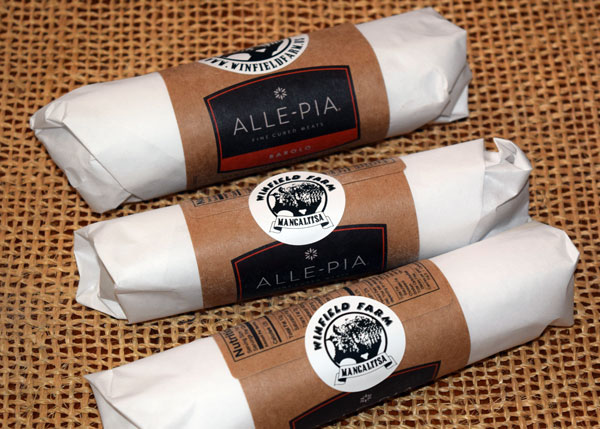
This story begins with a chance meeting with Antonio Varia, Chef and owner of Buona Tavola restaurants in Paso Robles and SLO, and his nephew, Alex Pellini. Both Antonio and Alex also create fine-cured meats at Alle Pia Handcrafted Italian Salumi. “It was our tradition in Italy to make salami each winter with our entire family,” Antonio says. He named his artisanal salumi-curing venture Alle-Pia in honor of his mother, Maria Pia Allesina. Their philosophy: “Alle-Pia Salami is made with the finest ingredients using traditional old world family recipes. Handcrafted and created with love under careful supervision in our USDA inspected state-of-the-art facility.”
Mangalitsa pork is renown for charcuterie, ranked among the best in the world for prosciutto, lomo, pancetta and the like. But what about salami? We posed the question to Chef Antonio and Alex. They had not worked with Mangalitsa before, but they were willing to try. We added another challenge: Alle- Pia’s traditional salami barolo recipe uses Italian wine — nebbiolo. But a local Santa Ynez Valley winery, Palmina, makes world-class nebbiolo also. What about producing a totally local product, utilizing Winfield Farm Mangalitsa pork and Palmina nebbiolo?
We approached Steve and Chrystal Clifton at Palmina and both were enthusiastic. Palmina is all about relationships. “Relationships that bring people back to the table to sustain themselves with good wine and food, conversation and a small respite from the hustle and bustle of today’s world.” According to the Palmina Wines website, “Palmina crafts wines that are a key part of that equation; wines that can be enjoyed everyday, and that complement and enhance a wide range of food styles.” Palmina produces wines from Italian varietals grown in Santa Barbara County, after Steve and Chrystal found that the climate and soil types here are similar to their favorite regions of Northern Italy.
Antonio and Alex also liked the local approach. So the experiment began. After close to two months of curing in Alle-Pia’s temperature-humidity-controlled room, we met to sample the results. Spectacular! Amazing! Creamy! Delicious! Actually, indescribably good!
So the partnership is cemented! Alle-Pia wants more Mangalitsa to cure (also eager to make lardo from Mangalitsa backfat and serve Manga loins in their Buona Tavola restaurants). Palmina Winery is planning to showcase Winfield salami Barolo at their 20th anniversary celebration in August, and will promote it in their tasting room. And we also will offer Winfield Farm Mangalitsa salami Barolo as a new product on our online Mangalitsa Market store.
Get it while you can! Supplies are limited now… (but we will be producing more…) https://www.winfieldfarm.us/?page_id=1111
Alle-Pia also makes a killer Tuscan salami with sangiovese – and Palmina also produces a sublime sangiovese…
A hand-written sign on the door to the curing rooms at Alle-Pia says, prophetically, “This is the beginning of something good.” Indeed! This partnership is just beginning… Stay tuned.
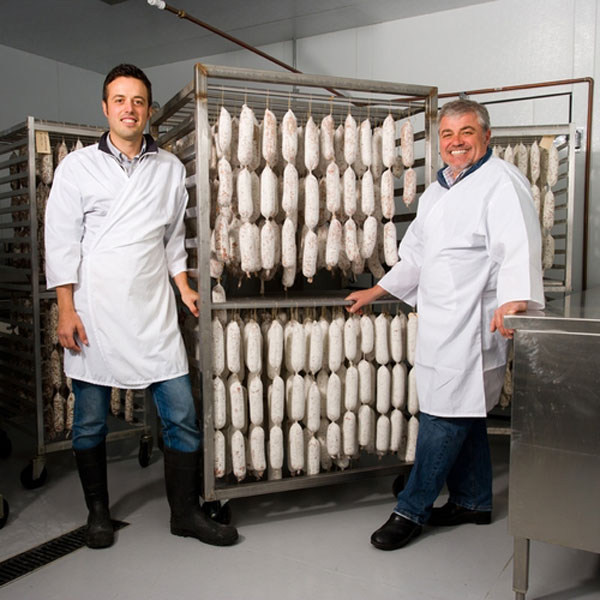
Alex Pellini and Antonio Varia
by Bruce Steele | Jul 13, 2015 | Uncategorized
— Republished from Edible Santa Barbara 2015 Summer Edition —
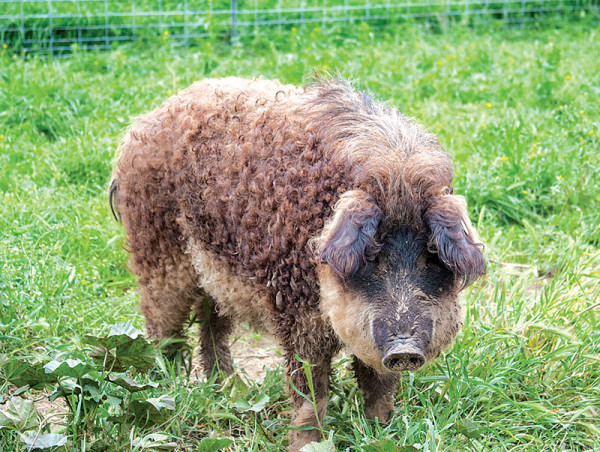
The Mangalitsa pig is a special breed known for its thick fat, but is also identified easily by its unique curly and wooly coat. Photo by Rosminah Brown.
Heritage Serendipity
Winfield Farm is run by Bruce and Diane Steele. Bruce had a longtime dream to have a pig that would help consume surplus produce on his farm. What ended up happening was an explosion of pigs that’s resetting the course of the farm’s operations and helping bring a heritage breed back into popularity that was once on a path of dying out.
Bruce started out as an urchin diver and fisherman, and in 2003 became a land farmer in Buellton on Highway 246 about three miles west of Highway 101. Winfield Farm is most easily spotted by his pale blue fishing boat parked at the base of the driveway. The farm had been in land production for 10 years before Bruce’s dream of having a pig first became a reality.
The Steeles specialize in just one heritage breed, the Mangalitsa, also called a Wooly Pig, and also known as a Lard Hog. The Mangalitsa stock hails from 19th century Eastern Europe. The Mangalitsa has exceptional fat and was the prize pork of Austro-Hungarian nobility at the turn of the century. Once you see how much fat is on its body, it’s a wonder this tenacious breed can move about quickly and easily at all.
The breed is considered rare, and it almost died out entirely. Because the Mangalitsa has so much lard, the breed was unpopular in the 1970s and ’80s when fat became unfashionable. Who remembers the ad campaign for “the other white meat?” It was almost extinction for the Mangalitsa. But thanks to the growing popularity of bacon and pork in general, a desire for rich flavor and unctuous texture in meat, and the recognition that genetic diversity is a good thing, the Mangalitsa is making a comeback and its smooth silky fat is now held in glorious esteem. Winfield Farm is currently the largest breeder of the Mangalitsa in Southern California.
The pigs are fed with fruit and vegetables from the farm with additional organic grain supplement. If Bruce sees an opportunity to feed them something local and readily available, he’ll give it to them. Like autumn acorns or winter squash. So much squash.
The Mangalitsa pigs seem to breed like crazy and the Steeles are excitedly incredulous at times that their initial investment in 2013 of a handful of pigs has become an increasing series of enclosures with their original pigs, then a serendipitous rescue of 13 additional Mangalitsas, plus their next generations. Now there’s new sets of spunky piglets that arrived over Christmastime, running around, squealing, rooting and foraging. They grow so quickly.
Bruce is often constructing new shelters for expectant sows to birth and nurse their young. It’s not all a fairy tale—the reality is that stillborns occur, and when some don’t make it due to a sudden cold snap or the lack of enough suckling teats to go around, it is upsetting to everyone. This is farm life and it comes with unanticipated death as well. As for their fondness of the Mangalitsa piglets, Bruce says with both a smile and a shake of his head, “they’re just so darned cute.”
Winfield Farm to Chef – Full of Life Flatbread
Winfield supplies whole pigs by order to local restaurants, such as Full of Life Flatbread in Los Alamos. Chef/owner Clark Staub purchased a whole Mangalitsa last summer, and he and his staff broke it down and processed it entirely. The specials menu ran fresh Mangalitsa dishes for several weeks, while its legs were set to cure for longer-term projects, like smoked hams, speck and lardo that started to grace dinner plates this past February.
Sourcing locally is important to Full of Life, and the relationship between farmer and chef in this case is especially close—Clark lives just a few miles away from Winfield Farm off Highway 246 and passes it daily on his way to the restaurant. Not only do we have the opportunity to eat this spectacular pork prepared by one of our county’s favorite chefs, but the two are collaborating on recipes for an upcoming Mangalitsa cookbook. Something to watch out for!
Resources
Direct purchase is available to the public, by ordering online or purchasing pork through the farm’s weekend produce stand. Winfield offers the magic of Mangalitsa in all varieties of cuts and processing. The primals, or basic large cuts, are the biggest and least expensive per pound, while packets of bacon, chops or sausages are available by the pound, which is a very approachable option for those making a first foray into local heritage pork. They are a great source for the Mangalitsa’s special feature: its fat. Both leaf fat and back fat can be bought, useful for making flaky pastry or cut into lean-meat sausages, respectively.
Slaughter and processing takes place farther north. Currently this requires driving the pigs to a USDA-certified slaughterhouse in Fresno; the Steeles hope to bring this closer to home when such an option becomes available. In Bruce’s ideal world, he would like to convert all this farming equipment to solar—even the tillers and plows.
Whole pig prices are $7 per pound, and are custom scheduled by contacting Winfield Farm. Select cuts in smaller portions range from $10 to $15 per pound. These can be bought by mail order, shipped or picked up in person at their weekend farm stand in Buellton.
Read the original post: Edible Santa Barbara
by Bruce Steele | Jun 25, 2015 | Mangalitsa Pigs
The conference called Fatty Pig on fat-type hogs (including the more and more famous Hungarian Mangalitsa) might bring scientific and economic results. The conference was organized for the second time by the Research Institute for Animal Breeding and Nutrition and WESSLING Hungary Kft. on November 21 and 22 in Herceghalom, and it was attended by researchers and businessmen from all around the world.
Fat-type hogs play a key role in the production of high quality pork! Fat-type hogs are usually bred only in small populations, but in many parts of the world, and they represent a premium segment within the sector, and also enormous national, genetic and economic value. To utilize these values, it is outstandingly important to investigate and to understand more thoroughly their physiological and genetic properties. Mangalitsa is more and more well-known in the world and more and more sought-after by consumers – said Dr. József Rátky, director general of the Research Institute for Animal Breeding and Nutrition, co-organizer of the conference.
With genetic analysis against counterfeiting
For successful performance of a premium product on the market, in order to eliminate counterfeiting, traceability is indispensable, which is achieved by performing the necessary background analyses and molecular biological-genetic research. This was the goal of the MANGFOOD project, an undertaking of Biomi Biotechnological Service Kft., a joint venture of the independent analytical laboratory WESSLING Hungary Kft. and the Agricultural Biotechnological Center.
As Adrienn Micsinai, general manager of Biomi told us that, together with several other enterprises and scientific laboratories, a gene sequence specific to the Mangalitsa was found during the MANGFOOD project, which is suitable for the fast and highly accurate determination of whether the given product is really made of Mangalitsa. This way it was possible to differentiate genetically between Mangalitsa and other pigs. This solution can be used not only for products containg only one type of meat, but also for mixed products, e.g. sausages, and even the percentage Mangalitsa content can be determined.
The journey of the Mangalitsa
Elimination of counterfeiting is extremely important, since Mangalitsa today has an outstanding role in the Hungarian meat industry – emphasized Dr. Lajos Bognár, deputy undersecretary of the Ministry of Rural Development responsible for food chain contol supervision and agricultural administration. Mangalitsa was in a critical state in the 1990’s, but it was resurrected thanks to the gene preservation program that was started in 1995.
The fate of other fat-type hogs all over the world was similar to that of the Mangalitsa – said Péter Tóth, president of the National Society of Fat-Type Hog Breeders and the Genetic Resources Council of Indigenous Livestock. Ancient breeds were close to extinction and they were revived – concurrently with the appearance of a new demand for quality meat – by a few eager breeders, learning almost in a self-educated way all there is to know about this animal. And then they were joined by research institutes and economic players.
Lo Chin-Hsien Ra, owner of 551 HORAI, an Osaka-based Japanese restaurant chain came to Hungary specifically for the sake of Mangalitsa. He had heard a lot about the breed, and had already encountered Mangalitsa products in Japan. This was not an accident, because – as was told by Endre Nagy, general manager of Pick Szeged Zrt., known internationally for its excellent salami, among other things – the leading product of the company, “téliszalámi”, has been present in the Hungarian and world markets for 145 years, and its raw material is high weight, high quality pork, i.e. Mangalitsa.
by Bruce Steele | Jun 7, 2015 | Mangalitsa Pigs
Spring is usually a busy time of year at Winfield Farm: tilling the soil, seeding and out-planting vegetable starts. This spring was doubly busy, with the arrival of 54 Mangalitsa piglets since March 18!
Although Bruce managed to plant some spring carrots, beets, potatoes, shishito peppers and heirloom tomatoes, and just finished planting a row of Costa Romanesco zucchini squash, most of his waking hours have been devoted to pig husbandry. In fact, heirloom Mangalitsa wooly pigs have become Winfield Farm’s mainstay!
Bruce has turned over most of our fields to pig rearing, so planted pasture instead of produce, and spends a lot of time building and moving fence. We corral our pigs with hog panels wired together so he can rotate the herd: when the little shovel-noses root up one section, he moves them to new turf. People driving along Highway 246 from Lompoc to Buellton can spy our herd of purebred swallow-belly Mangalitsas cavorting in the field. These wooly haired pigs look a lot like black sheep.
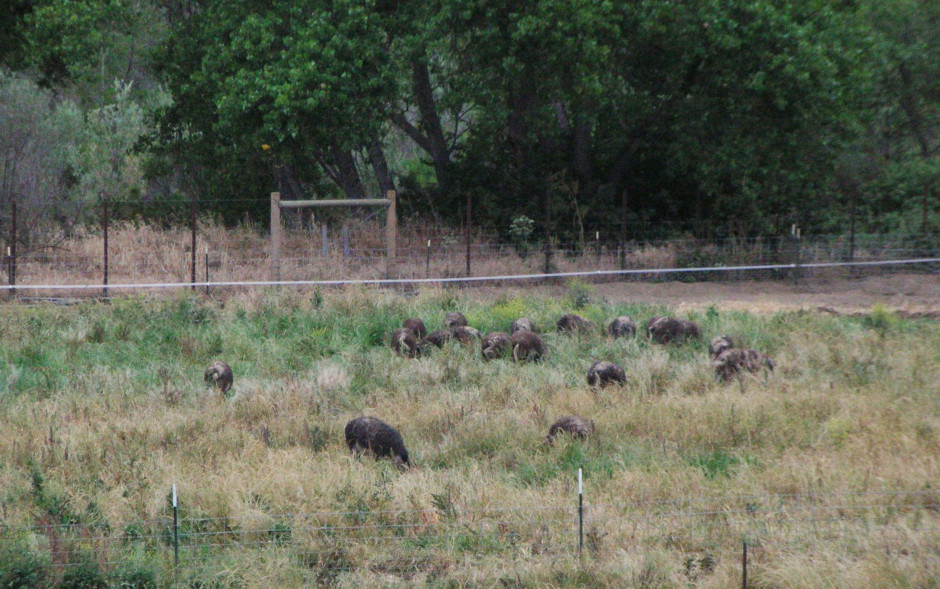
The 54 new arrivals are the offspring of 8 sows and 4 boars (3 more sows produced another 20 piglets last winter) – so our Mangalitsa herd now numbers more than 100 pigs total. It’s amazing to think that just 2 years ago we began this pigdom with only two pigs. We’re now able to provide fresh (or fresh-frozen) Mangalitsa pork virtually year-round.
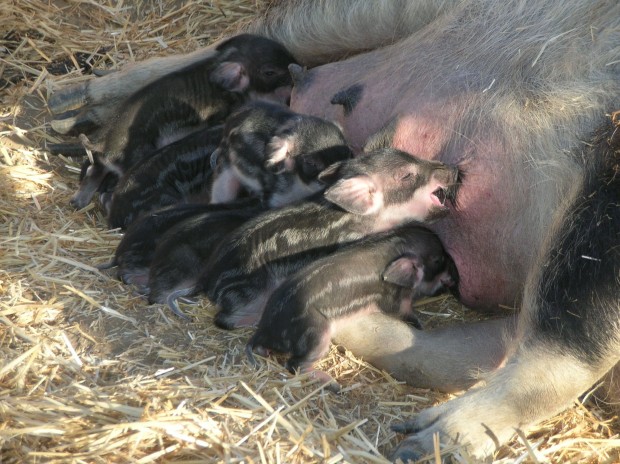
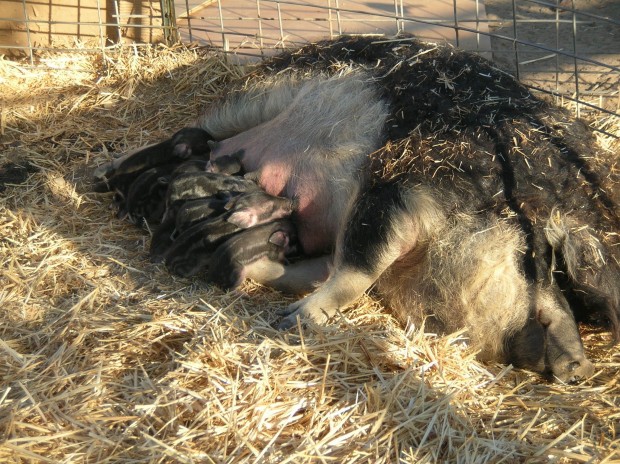
We’re marketing our heritage Mangalitsa pigs to a growing number of discerning restaurants in the Santa Ynez Valley and beyond. For example, you’ll often find Winfield Mangalitsa prosciutto, lomo and pancetta at Industrial Eats restaurant in Buellton, and Clark Staub at Full of Life Flatbread in Los Alamos makes magical dishes – and pizzas – with Winfield Mangalitsa pork.
We also offer USDA certified, cryovac packaged frozen Mangalitsa pork products on our online Mangalitsa Market store.
We recently took several pigs to market, so have a fresh supply of frozen cuts available, including chops (a handful of skin-on, bone-in loin and a lot of skin-on, bone-in rib with a glorious cap of pure white Mangalitsa fat), bone-in sirloin roasts, smoked hams (both bone-in and boneless), sliced bacon (and a couple of belly slabs), ground sausage (fresh and sweet Italian flavors in bulk 2-lb packs), smoked hocks (yummy!), trotters and leaf lard (the best baking fat EVER!).
Please call us at (805) 686-9312 or email us at bruce@winfieldfarm.us to order.
Or you can order from our online store, but please call first to make sure we still have what you want. If we don’t have it now, we can custom-order it for you the next time we go to market. We’ll be taking more pigs to market in late June, and at least monthly throughout the summer and fall.
If you haven’t tried Mangalitsa pork yet, you’re in for a treat. Try Winfield Mangalitsa and taste the magic for yourself!







